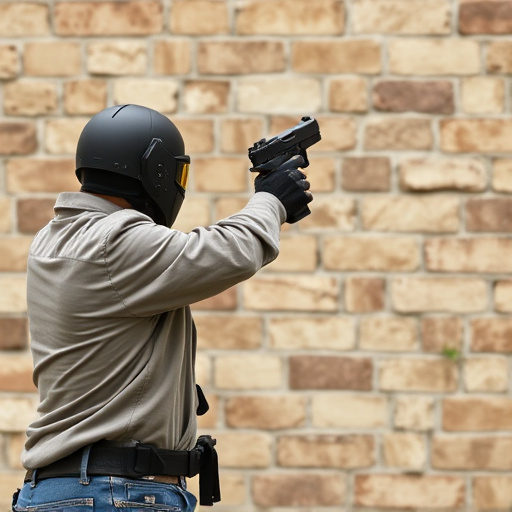Rechargeable Stun Gun Batteries: Performance, Safety, and Science
Stun guns, effective self-defense tools, rely on rechargeable batteries, primarily lithium-ion (Li-i…….
Stun guns, effective self-defense tools, rely on rechargeable batteries, primarily lithium-ion (Li-ion) or nickel-metal hydride (NiMH), for optimal performance and safety. These batteries deliver high voltage pulses through metal probes to temporarily disrupt the nervous system, causing muscle spasms and incapacitation. Key factors like voltage, ampere-hour (Ah) rating, and charging time influence stun gun effectiveness. Proper maintenance, including regular cleaning and adhering to manufacturer guidelines, ensures battery longevity and consistent stun gun performance, enhancing personal safety while minimizing potential health risks associated with prolonged or repeated use. Understanding the mechanics of stun gun effects on the nervous system is crucial for both safe deployment and regulatory considerations.
Rechargeable stun guns are a popular choice for personal safety, offering convenience and cost-effectiveness. This article delves into the crucial aspect of stun gun battery specifications, exploring how rechargeable batteries impact device performance and user experience. We examine various types, technologies, and key features to ensure optimal effectiveness. Understanding the science behind stun guns’ effects on the nervous system is also essential, providing insights into their operation and safety considerations for maintaining long-lasting batteries.
- Understanding Stun Gun Batteries: Types and Technologies
- The Role of Rechargeable Batteries in Stun Gun Performance
- How Stun Guns Affect the Nervous System: A Scientific Perspective
- Key Battery Specifications to Consider for Effective Stun Guns
- Safety and Maintenance: Ensuring Your Stun Gun Battery Lasts
Understanding Stun Gun Batteries: Types and Technologies

Stun guns, a powerful personal defense tool, rely on rechargeable batteries to deliver their stunning effect. Understanding the battery types and technologies is crucial when considering the effectiveness and performance of a stun gun. The most common stun gun batteries are lithium-ion (Li-ion) and nickel-metal hydride (NiMH). Li-ion batteries offer higher energy density, making them lighter and more compact while providing longer lasting power. These batteries also have a lower chance of leaking or swelling compared to NiMH alternatives.
The stun gun’s ability to disrupt the nervous system is contingent upon its battery voltage. Higher voltage batteries can deliver more powerful shocks, ensuring maximum stun effect. Rechargeable batteries in modern stun guns are designed with safety features to prevent overcharging and overheating, which could reduce battery life or even pose a risk of fire. These advanced technologies ensure reliable performance, making stun guns a dependable option for personal safety.
The Role of Rechargeable Batteries in Stun Gun Performance

The performance and effectiveness of a stun gun heavily rely on the power source, and rechargeable batteries play a pivotal role in this regard. These advanced batteries offer numerous advantages over traditional non-rechargeable alternatives. One of the key benefits is their ability to deliver consistent voltage, ensuring the stun gun functions optimally each time it’s deployed. This is particularly crucial when considering the stun gun’s effect on the nervous system, as a stable power source is essential for imparting the required electrical shock that disrupts nerve impulses and causes temporary incapacitation.
Rechargeable batteries also contribute to the overall sustainability and cost-effectiveness of stun guns. By eliminating the need for frequent battery replacements, users can significantly reduce expenses and minimize waste associated with disposable batteries. This makes them a practical choice for individuals seeking reliable self-defense options without compromising on performance or environmental considerations.
How Stun Guns Affect the Nervous System: A Scientific Perspective

Stun guns, also known as electronic control devices (ECDs), work by delivering a high-voltage, low-current electrical pulse into the body, typically through two metal probes. This sudden jolt disrupts normal muscle function and motor control, leading to temporary incapacitation. From a scientific perspective, this disruption is primarily centered on the nervous system. The electrical current interferes with nerve impulses, specifically those responsible for controlling voluntary muscles, causing them to spasm or lock up.
The effects are rapid and short-lived due to the low current levels. This precise targeting of the nervous system allows stun guns to neutralise an assailant without causing permanent harm or significant pain beyond the immediate shock. However, repeated or prolonged exposure to such shocks can lead to potential health risks, including muscle strain, heart palpitations, and in rare cases, more severe neurological side effects. Thus, understanding the precise mechanics of how stun guns affect the nervous system is crucial for both their safe use and regulation.
Key Battery Specifications to Consider for Effective Stun Guns

When selecting a rechargeable stun gun, understanding its battery specifications is crucial for ensuring effective and reliable performance. The battery is the power source that drives the stun gun’s electric current, which disrupts the nervous system, causing temporary incapacitation. Key factors to consider include voltage, ampere-hour (Ah) rating, and charging time.
Voltage, measured in volts (V), determines the strength of the electrical shock. Higher voltage typically delivers more powerful stun effects on the nervous system, but it also increases the risk of pain and potential injury if not used correctly. Ampere-hour rating, indicating battery capacity, plays a role in duration of use; higher Ah values allow for longer operation between charges. Charging time varies among models; faster charging times are advantageous for frequent users who require prompt recharging.
Safety and Maintenance: Ensuring Your Stun Gun Battery Lasts

The rechargeable battery powering your stun gun is a critical component, both for its functionality and safety. Regular maintenance and proper handling are essential to ensure the battery remains in top condition and delivers the stun gun’s maximum effect on the nervous system. Unlike disposable batteries, which can degrade over time, rechargeable batteries require specific care to maintain their performance and longevity.
This includes regular cleaning of the battery contacts, avoiding extreme temperatures, and adhering to the manufacturer’s guidelines for charging and storage. Overcharging or undercharging can damage the battery, reduce its cycle life, and potentially affect the stun gun’s effectiveness when you need it most. Understanding and following proper maintenance practices will help ensure your stun gun is always ready to deploy the powerful effects on the nervous system required to deter potential threats.
In conclusion, the performance of a stun gun is significantly influenced by its rechargeable battery, which plays a crucial role in delivering effective shocks. Understanding the various battery types and their specifications, such as voltage, capacity, and charging time, is essential for ensuring optimal stun gun functionality and safety. Moreover, knowing how stun guns affect the nervous system provides valuable insights into their operation. By considering these factors and implementing proper safety and maintenance practices, users can maximize the effectiveness of their stun guns while minimizing potential risks.


